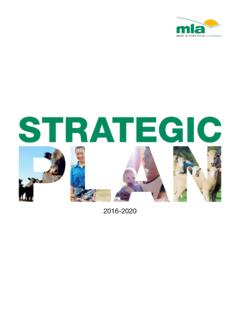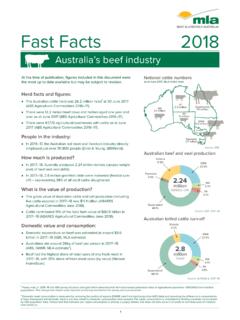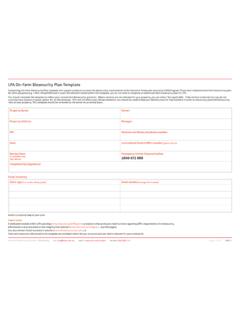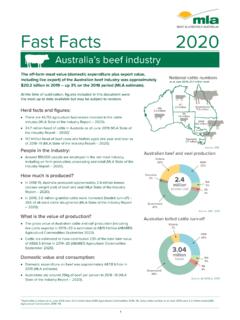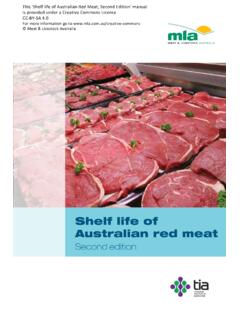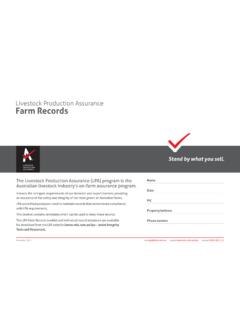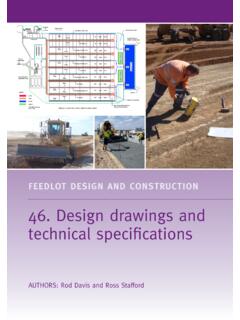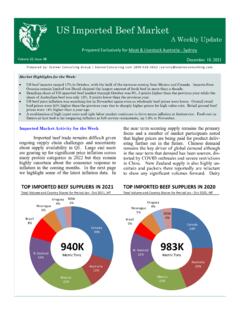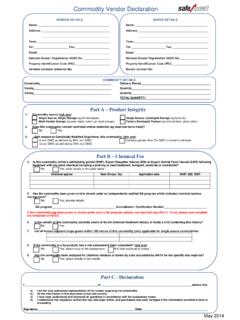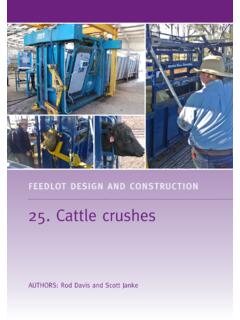Transcription of Guidelines for the safe retailing of meat and meat products
1 Guidelines for the safe retailing of meat and meat products Intentionally blank pageISBN 9781741919547 Meat & Livestock Australia, 2012. ABN 39 081 678 makes no representation as to the accuracy of any information or advice contained in this publication and excludes all liability, whether in contract, tort (including negligence or breach of statutory duty) or otherwise as a result of reliance by any person on such information or advice. This publication is only intended to provide general information. You should make your own enquiries before making decisions concerning your for the safe retailing of meat and meat productsiAcknowledgementsThanks go to the Retail Butchers Panel Peter Bouchier Butchers of DistinctionKevin Cottrill AMICRay Kelso Barrow Lane ButchersEddie Kowalski Eddie The ButcherDominick Melrose Royal Chef Selection Neil Roberts Mrs.
2 Beetson s JewellstownMichael Salm Salm s MeatsRod Sellers R&R Sellers Quality MeatsThanks also go to Paul Crick NSW Food AuthorityPeter Horchner Symbio AllianceJodie Hummerston MINTRACG eoff Raven PIRSAIan Jenson Meat & Livestock AustraliaJohn Sumner Meat & Livestock AustraliaJulie Balan Meat & Livestock AustraliaiiContentsIntroduction Food Safety Plans for butcher shops ..1 What you need to do after reading these Guidelines ..2 What these Guidelines help you do ..3 Roadmap to these Guidelines ..3 Glossary of terms ..4 Part 1So what s the problem what are the hazards you need to control? ..5 Food poisonings from meat and meat products ..5 Product recalls.
3 6 Part 2 So how risky is my business?..7 Risk assessment ..7 Cross contamination in your premises ..7 Butchers just like you shocking tales! ..8 You re thinking It couldn t happen to me ..9 Check out your business rate your risk ..10So I m a low risk business no worries? ..11 Danger signals ..11I can see I have a high-risk business what should I do? ..12 Part 3 Cleaning procedures for retail butcher shops .. 13 Construction of the processing area ..13 How to clean your premises ..14 Stages in cleaning ..15 Some do s and don ts ..15 Part 4 safe food handling .. 17 Use hygenic handling practices ..17 What do we mean by safe food handling? ..17 Clothing ..18 Hands.
4 18 Health ..18So what s on a butcher s hands? ..18 Part 5 Control of chemicals and allergens .. 19 Control of preservatives sulphite level in fresh sausages ..19 Allergen control ..20 What can I do to look after my customers? ..20 How can I stop allergens getting in? ..20 Labelling ..21iiiContentsPart 6 Critical Control Points for raw products in a low risk business .. 23 Low risk hazards ..23 Critical Control Points (CCPs) in a low risk business ..24 Process flow diagram: raw meats and meat products ..25 Hazard worksheets and HACCP charts .. 26-31 Part 7 Controlling hazards in a high-risk business .. 33 Ready-to-eat meats ..33 Critical Control Points (CCPs) in a high risk business.
5 34 Process flow diagram: cured and cooked meats ..36 Hazard worksheets and HACCP charts .. 37-38 Part 8 Preventing cross contamination of RTE meats .. 39 Now for the hard part ..39 Vulnerable consumers ..39 Reducing the risk ..40 Appendix 1 Target bacteria and how to control them .. 41 What are target bacteria? ..41 The problem ..41 Bacteria growth ..42 What do bacteria need? ..42 Controlling bacteria in your operation ..43 Salmonella ..44 Pathogenic Escherichia coli ..45 Listeria monocytogenes ..46 Staphylococcus aureus (Golden Staph) ..47 Clostridium perfringens ..48 Clostridium botulinum ..49 Campylobacter ..50 Appendix 2 Improving product consistency .. 51 Variation of products and processes.
6 51 Appendix 3 What does a good food safety plan look like?.. 53 Food Safety Plan (FSP) ..53 Setting up your HACCP Manufacturing Practices (GMPs) for retail butcher shops ..55 Cleaning procedures for retail butcher shops ..56 Typical hazard control worksheet ..57 Typical HACCP chart ..57ivFor more information on these resources go to: Safety Plans for butcher shopsIn 1998 the National Meat Association (NMA now the Australian Meat Industry Council, AMIC) asked Meat and Livestock Australia (MLA) to help in preparing Food Safety Plans (FSPs) for independent butchers. At the time HACCP was just being introduced into the meat industry following a number of incidents in which consumers died or were seriously injured:These incidents led to food safety plans being mandated for all sectors of the meat industry and, over the period since 1998, there have been other problems in which consumers have died, with ready-to-eat meats being the cause.
7 Food Safety Plans for independent butchersIn the USA, consumption of hamburgers from the Jack-in-the-Box chain killed seven children and injured more than 50 othersIn Australia, one child died and more than 150 were injured following consumption of mettwurst manufactured by Garibaldi SmallgoodsIn response, meat regulators have gradually introduced new requirements for the industry, requirements which apply to butcher shops and manufacturers, alike, the most recent being the Regulatory Guidelines for the control of Listeria. For this reason, AMIC and MLA have produced resources such as videos, Guidelines and booklets to help the industry meet increased requirements: Guidelines for the safe manufacture of smallgoodsSafe manufacture of value-added products (DVD)Listeria monocytogenes in smallgoods: risks and controlsHow to comply with regulatory Guidelines for the control of Listeria by meat retailers: advice on how to set up a testing programReducing the risk of Listeria monocytogenes in smallgoods123451 IntroductionWhat you need to do after reading these Guidelines1.
8 Write work instructions or monitoring forms only you can do this, for your individual operation, and for approval by your controlling Set out how you meet all the provisions of the Food Standards Code. You need to do this before your regulator will sign-off on your food safety plan: Standard (Interpretation and Application) Standard (Food Safety Programs) Standard (Food Safety Practices and General Requirements) Standard (Food Premises and Equipment) Standard (Production and Processing Standard for Meat) AS 4696:2007 (Australian Standard for Hygienic Production and Transportation of Meat and Meat products for Human Consumption)122 HIGH RISKLOW RISKR oadmap to these GuidelinesIntroductionIn these Guidelines we.
9 12 What these Guidelines help you doProvide a risk rating for your operation34 Suggest ways you can reduce the risk to your customersSupply scientific backing for your Food Safety PlanProvide background information to support training programs for owners of butcher shops, staff and apprentice butchers - don t forget, you have a regulatory requirement to make sure you and every staff member have the skills and knowledge to manufacture all your products 1 HazardsRisksControlsAppendicesPart 2 What hazards may be found in retail meat products ? Bacteria Chemicals Allergens Foreign matterHow risky is my business? Raw meat and poultry only Cooked and RTE products are brought in and sold without repacking products are cooked products are fermented RTE product is sliced and packed Product supplied to hospitals, aged care homes, meals-on-wheels, schoolsParts 3 to 8 Appendix 1 Target bacteria and how to control themPart 3: Cleaning proceduresPart 4: safe food handlingPart 5: Control of chemicals and allergensPart 6: Critical control points for raw products in a low risk businessPart 3: Cleaning proceduresPart 4: safe food handlingPart 5: Control of chemicals and allergensPart 7: Controlling hazards in a high risk businessPart 8.
10 Preventing cross contamination of RTE meats Appendix 2 Improving product consistencyAppendix 3 What does a good food safety plan look like?33 Glossary of terms< ..Less than, as in less than 10> ..More than, as in more than 10 Ambient temperature ..Temperature of the air around you or the productAMIC ..Australian Meat Industry CouncilAnaerobic ..The absence of oxygen, a state which can exist in canned and vacuum-packed productsaw ..Water activity Calibration ..Measurement of the accuracy of a piece of equipment a thermometerCold chain ..The process of maintaining foods under refrigeration, in either a chilled or frozen state, during storage, distribution and marketingComminuted.
